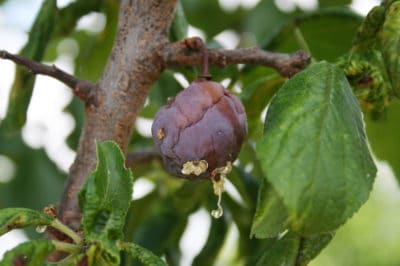Identifying Plum Pox Virus in Trees
Plum pox virus also infects peach, nectarine, apricot, and cherry trees. The symptoms include:
- Yellowing and other changes in the pigmentation of fruit skin, including development of lines and rings,
- Premature falling of fruit, especially in plums,
- Deformation of fruit shape and necrotic spots on surface,
- Irregularities in flower color on varieties with large blossoms,
- Decreased fruit yield,
- Red discoloration of flesh in plums,
- Generally poor tree health and vigor.
Symptoms are often not apparent in the first year or two of infection. However, decreased fruit yield is one sign often seen in trees without any other apparent symptoms.
Spread of Plum Pox Virus
The virus is spread by aphids and often transmitted from one location to another through bud-wood from cuttings or newly introduced trees grown from stock infected with the virus. So, when planting new plum trees, or harvesting bud-wood for grafting, make sure the source location is free from this damaging disease.
Since there is no treatment for plum pox virus and the pathogen can cause devastating problems in an orchard, preventing the introduction of the virus is crucial.
Preventing Plum Pox Virus
The best way of preventing plum pox virus is by planting trees certified as free of the virus through testing. Immediately removing infected trees and disposing of the debris off-site or by burning is necessary to prevent the virus from spreading to plum and other stone fruit trees in the area.
In some cases, removing other stone fruit trees near an infected tree is needed to eradicate the disease from an orchard.
Stumps from old trees infected with plum pox virus should be ground out with a stump grinder or treated with herbicide to prevent re-sprouting because new shoots from the root stock can continue to harbor and spread the pathogen.
Plum pox virus is a bigger problem in some locations than others. Resistant cultivars can harbor the virus but do not usually express symptoms of the disease. Consider planting resistant varieties if you live in an area with frequent problems with plum pox virus. Local University Extension offices have information on fruit tree diseases common to specific locations around the U.S.
